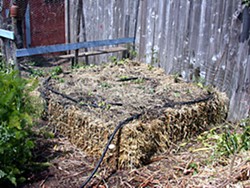[
{
"name": "Top Stories Video Pair",
"insertPoint": "7",
"component": "17087298",
"parentWrapperClass": "fdn-ads-inline-content-block",
"requiredCountToDisplay": "1"
}
]
A couple weeks ago, I wrote about my new experiment in vegetable gardening. The idea was to build raised beds out of rice straw bales, creating a no-dig bed that would basically turn into one giant compost pile at the end of the season. I heard from several people who were interested in trying the same thing themselves, so I told them I would report back and let you know how the setup went.
I ended up buying four rice straw bales and arranging them in a square, with an opening in the center that I filled with straw and compost. Most of the instructions I'd read about straw bale gardening said to place the bales on the narrower edge, so that the cut end of the straw was facing up and the strings were running around the sides of the bales. The rationale for this arrangement is that it is easier for plant roots to work their way down into the straw if the straw itself is running perpendicular to the ground rather than parallel.
But I didn't like the way that looked, so I did it the other way. With the straw bales sitting on their edges, the whole thing seemed unreasonably tall. This might be a good thing if you're trying to avoid bending over too much, but I liked the look of the bales when they were flat on the ground, and besides, they covered more ground that way. This is exactly the sort of approach that gets me into trouble with experiments like this: I am always disregarding the advice of others who have gone before me and making impractical changes for impractical reasons.
So I set my bales down on the ground and, without cutting the strings to loosen the bales, I roughed them up with a spading fork and pulled out enough loose straw to fill in the hole I'd left in the center. Then I topped the whole thing off with a couple inches of compost and watered it thoroughly.
At this point, according to the directions I'd read, the bales would start to heat up like a compost pile and would decompose a little. After about 10 days of this, they would cool off and be ready for planting. During those ten days, I added a little more compost, continued to water every day and poured in organic liquid fertilizer to help infuse the straw with beneficial microbes and nutrients. And it did cook: According to my soil thermometer, temperatures inside the bales reached a hundred degrees. A true hot compost pile is supposed to reach 160 degrees, but I was happy just to see it get hot enough to produce a few wisps of steam now and then.
As predicted, after about 10 days the bales cooled down. By then, the straw had decomposed enough that I could easily rake more of it out of the bales, fill those holes with compost, and plant right into them. I ran a soaker hose back and forth across the bales so that they would be easy to water, and then I planted all the vegetable starts I bought at the farmers market: tomatoes, beans, peas, herbs, squash and broccoli. In all, I put about 40 plants into a 36 square-foot vegetable bed.
Many of you are probably looking at the photograph of my little garden and wondering how I could plant a vegetable patch with such an obvious flaw: It is inaccessible on two sides. To get to the opposite corner of the bed, I have almost no choice but to step right in the middle of it. This is indeed a foolish design, but it represents a compromise. This is the only spot in my garden that gets full sun, and I'm hoping that the heat bouncing off the fence will keep the tomatoes happy. It's also convenient to have the chicken wire that encloses my chicken coop as a trellis for the beans and peas to climb up — as long as the chickens don't reach through the wire and eat every pod before I do.
My plan is to continue feeding this straw bale garden with organic liquid fertilizer and a very informal sort of compost tea made by mixing worm castings with water and pouring the mixture straight into the garden. The plant roots will eventually grow right into the straw bales, so they'll need some extra nutrients.
Meanwhile, it's a relief to know that I won't have to bother with pulling weeds, and it's nice to have such a small, densely planted vegetable garden that is easily watered by soaker hose. With any luck, I'll have a harvest in a few months. I'll keep you posted.
Comments
Showing 1-1 of 1
more from the author
-
NCJ Archive: Bring on the Bugs
- Oct 28, 2020
-
Cocktail Garden Crazy Talk
- Jun 13, 2013
-
Now You're Pushing It
- May 9, 2013
- More »
































